



 The Accurate Reloading Forums
The Accurate Reloading Forums  THE ACCURATE RELOADING.COM FORUMS
THE ACCURATE RELOADING.COM FORUMS  Hunting
Hunting  American Big Game Hunting
American Big Game Hunting  Bullet Failures.
Bullet Failures.Go  | New  | Find  | Notify  | Tools  | Reply  |  |
| One of Us |
This is one of those subjects that rear its head from time to time that always gets mixed responses. Not dealing with brand of bullet on this, just personal definition of "Bullet Failure". Even the rocks don't last forever. | ||
|
| One of Us |
If I kill the animal,I give a freak what happens to the bullet.I have never even looked to find them on purpose. | |||
|
| One of Us |
If you recover the bullet, that means the animal is dead and recovered. To me that means the bullet did it's job. US Army 1977-1998 | |||
|
one of us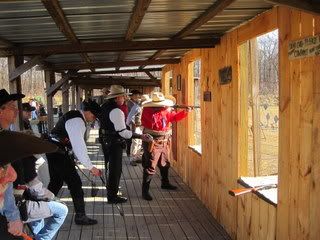 |
voted minimal penetration, but honestly--- if there is not an exit wound the bullet failed in my book! | |||
|
| one of us |
I have recovered 2 bullets that did not perform as expected. 1 was a 470 TBSH solid that riveted and the other was a 375 TBSH solid that bent. Both animals died so no failure just unexpected results. BigB | |||
|
| One of Us |
As far as I am concerned, if the critter is dead the bullet did its job. | |||
|
| One of Us |
CHC, If I have 5 hogs under a feeder and my bullet only kills three that are in line, and the other two run off, would that bullet be considered a failure? on the other hand, If I do shoot an animal and he runs off and I can't find him, I usually don't blame bullet (unless it's a ballistic tip Best GWB | |||
|
One of Us |
The statements along the lines of "If the bullet killed the animal, it worked" are really incomplete. Certainly, on game such as deer or Elk, that may or may not be true. It's hard to argue that a dead animal isn't dead!! However, I look at it a bit differently. Elk are often not shot with a 100 yard, unobstructed, broadside shot. Many times, the only hard fought for and won shot is a severe quartering angle to the vitals. A bullet that penetrates 5 or 6 inches before disintegrating into schrapnel will not allow you to take that shot as a big mature Bull Elk can provide a lot of resistance. For me, I want a bullet to open reliably, but retain most of its weight, drive all the way through the animal from whatever angle, and exit. That is my definition of a proper bullet as well as a proper caliber of rifle for the game at hand. Where this really becomes more of an issue is on animals that have the ability to bite or stomp you. A bullet that comes apart after 5 or 6 inches of penetration is hardly the correct medicine for something like a Brown Bear. Whitetail Deer, no problem; usually. But even with that Whitetail, do you want to HAVE TO wait for that broadside shot or do you want to be confident that the bullet will make it to the vitals from whatever angle you are presented with? | |||
|
| One of Us |
Geedubya, I don't care how many folks get their knickers in a bunch over this, but I have found myself using that same criteria looking at does under a feeder! I catch myself trying to line up 2 or 3 together, and I know either the Whelen or the .375 is more than capable of punching thru more than one little Texas doe. I am one of those that only worry about bullet performance if or when I find a bullet/bullet fragments. The reason I went to Barnes bullets was because of 3 seperate incidents of finding the remains of the Hornady's I was using in the animals I had shot. In all three cases, the critter was dead, but the bullets had basically disinegrated. The largest pieces were parts of the jacket. It is not fun finding or explaining to people you have given meat to, all the little pieces of lead in it. Also, I am one of those that wants minimal meat damage. So far the Barnes consistently give me the results I want. Even the rocks don't last forever. | |||
|
| one of us |
I consider bullet failure to be when my hunter shoots an animal with what would normally be a fatal shot and I end up tracking the thing down to finish it off. For the past several years, this has only happened one time with an old cup & core bullet, never with Accubond, Partition, or TBBC, but several times with Barnex bullets. Pancho LTC, USA, RET "Participating in a gun buy-back program because you think that criminals have too many guns is like having yourself castrated because you think your neighbors have too many kids." Clint Eastwood Give me Liberty or give me Corona. | |||
|
| One of Us |
That is why I use the rifles I do, but, that topic might be better served in a different discussion, I do however feel that it does have something to do with some bullet failures. I feel that it would be better addressed in its own discussion. JMO. Even the rocks don't last forever. | |||
|
| One of Us |
Wouldn't you say that is the performance goals of all hunting bullets we use? I am perhaps a luddite but I can't see abandoning a tried and true bullet that has achieved those goals for years simply because yet another new magic bullet hits the market with promises that exceed the laws of physics? Aim for the exit hole | |||
|
One of Us |
I would say so but others here don't seem to. I made this comment in response to the "Well it killed the animal so it worked" line of thought expressed by a couple of guys here. And that may be just fine with deer and animals of that nature. It doesn't work so well as a theory once you start hunting dangerous game and you need the ability to reach the vitals from any angle. | |||
|
| One of Us |
I don’t usually get tooooo involved in this type of discussion, however it’s a slow Sunday afternoon, so what the hey! So, with that, a short soliloquy! At my advanced age, I find myself in the camp of those who have never hunted “dangerous game” on this or a foreign continent, and do not have any immediate plans to do so. Some of the hogs I’ve shot could sure rip you a new one, but that’s another matter. Consequently, pretty much every thing I shoot winds up being deer, hogs and varmints. Having said that, words do mean things. I tend to think that the term “bullet failure” is to a degree a misnomer. Out of the hundreds of animals I’ve dispatched over the last 50 years or so, I don’t think I’ve ever had a bullet fail. I’ve used the WRONG bullet for the intended purpose. I’ve also been guilty of less than optimal shot placement. In each case, one could probably be more correct if he stated that it was not the bullet that failed, but the operator. Where I hunt, for the most part, cover is very close and very thick. If one cannot find a blood trail within 10’ or so of the point of impact, game is many times lost. Consequently I strive for DRT results. So whether the bullet remains in the animal or passes through, if the animal is not DRT, one could consider that bullet failure? Here are four bullets I’ve recovered from game. The first three you might say failed. IIRC, in each case the animal was DRT and the game was recovered (or else I would not have the bullet/residue).  The fourth was a Barnes Triple Shok. I shot this 182 lb (live weight) Axis stag at +/- 85 yds. I was shooting a 7mm-08, 140 gr. bullet at +/- 2,800 fps.  He was turned, say 11 to 5 toward me. The bullet caught him at his right shoulder and lodged against the hide on his left hind. He dropped at the shot, then got up and ran about 20 yds. I was going to put another round in him but he dropped again. When I walked up he was still alive so I dispatched him with my pistol. I’ve also lost two hogs shot with a 300 WSM using triple shocks. I do believe I hit them high and they penciled through. I’m sure if they were recovered they would look similar to the one taken from the Axis. So three different animals, two not recovered and one that should have been dispatched much sooner. Would you say that the Barnes bullet failed to do its job? Another example, Here’s a hog shot at 124 yds, using a 325 WSM with 180 gr. ballistic tips, velocity, say 2,850 fps. 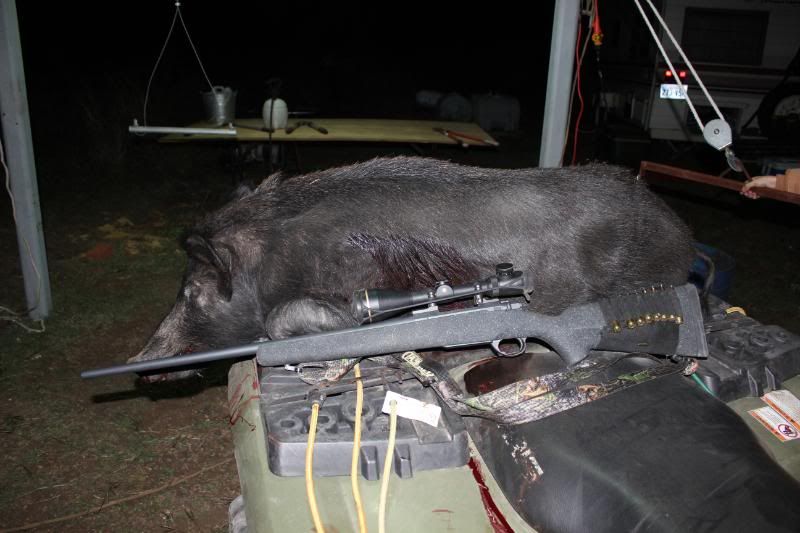 Plenty of blood for tracking,  Complete pass through, the bullet was not recovered. 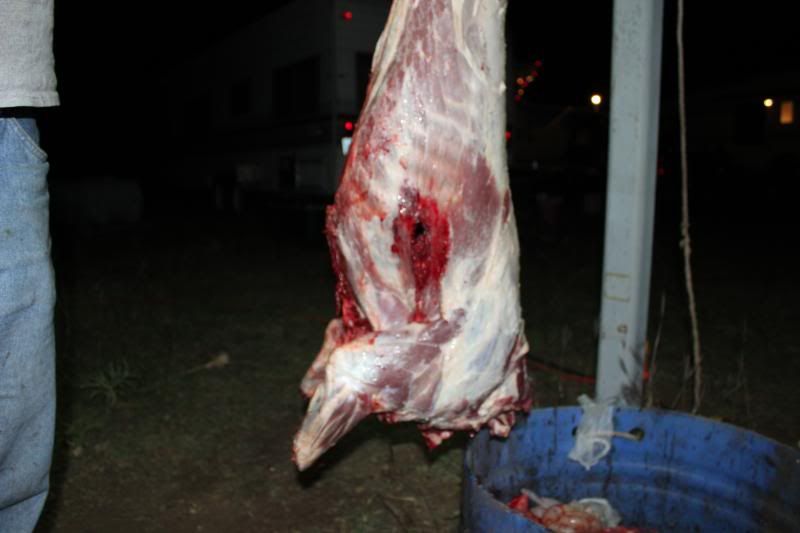 exit 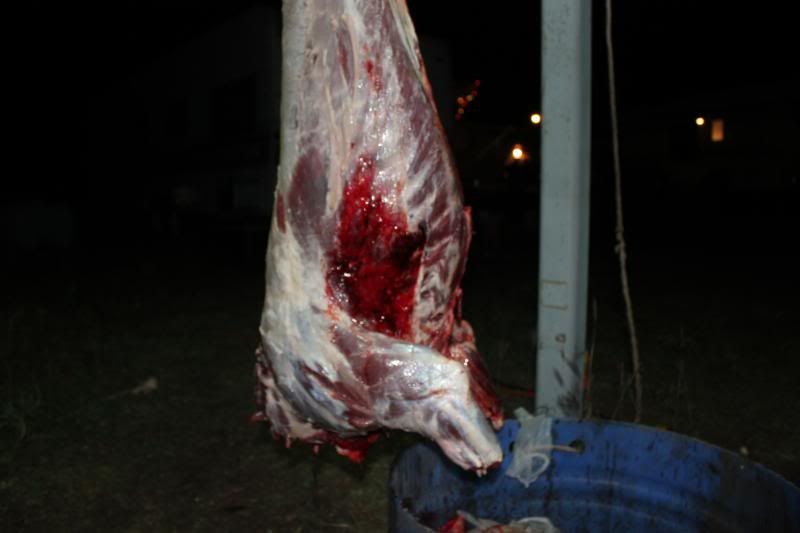 entry Yet the beast ran over 100 yards before expiring. So a bullet of sufficient weight, caliber was used but the animal was not DRT. Yet here is a dink I culled. Distance was about 80 yds. I was using a Tactical 20, loaded with a 40 gr. v-Max at 3,850 fps. Bang, Flop, DRT. The bullet exploded on the surface. 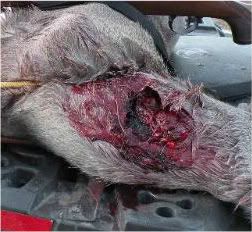 Did the bullet fail? Quien Sabe? Your thoughts? (Feel free to flame) Best GWB | |||
|
| One of Us |
Many Thanks to all that have responded and voted. Discussions such as this are what sites klike this were intended for. While I am one of those that does not worry about bullet perform,ance as long as the critter I shoot at dies. I do understand Todd's POV, and that is why I use the rifles/calibers that I do. It is also why I use premium bullets. I want to be able to take any shot offered. While I do shoot from a stand most of the time anymore, ocassionally I do get to do some spot and stalk hunting and I use something that I am comfortable taking any shot available. Not everyone however needs or wants the same thing out of a caliber/bullet combination. When you include/take hunting dangerous game into the equation, things take on a different aspect. Not all of us hunt dangerous game however and not all of us hunt as many species under the differing conditions as others. There is room for all the different philosophies on bullets, their successes and their failures, simply because each of us have our own expectations. Even the rocks don't last forever. | |||
|
One of Us |
Interesting responses on this thread. Lots of different experiences that seem to contradict each other. Here is what I've seen over the past 17 or so years since I switched to the Barnes X and TSX and even TTSX lately. I don't remember how many animals I've personally shot, but it's been well over 100. They have ranged from the 10 lb or so Steinbuck to Whitetail, Pronghorn, Caribou, Moose, Impala, Gemsbok, Kudu, Red Hartebeast, Eland, Blue and Black Wildebeast, Blesbock, Zebra, Tahr, Red Stag, Elk, Chamois, Black Bear, Brown Bear, Leopard, Lion, Nyala, Cape Buffalo, Warthogs, wild hogs, Hippo, Bushbuck, Elephant, Sable and quite a few others, many in multiples. Point being that there have been a large variety. Of course, the Elephants were not shot with TSX bullets, but rather solids. All the others were shot with the Barnes TSX with the exception of one Black Bear taken with the CEB Non-Con. Calibers have ranged from .243Win, .270Win, 7mm Rem Mag, 30/06, 300H&H Mag, 300WBY Mag, 340WBY Mag, 375H&H Mag, 416Rigby, .458WM, and the 500NE. Point being that there has been a wide variety of calibers and rifles. To put a fine point on it, my personal experience has not been one or two species with one or two calibers, but rather a sampling of a wide variety on both. Every one of those animals were one shot kills with the TSX bullet and found dead within 10 steps of where it was shot with a few notable exceptions. The exceptions have been notoriously tough animals such as several Cape Buffalo (multiple shots), my second Brown Bear (multiple shots), and a 1 Zebra (ran about 75 yards). I also had a Moose take a second shot to put down but he stopped in his tracks on the first shot and was pretty sick on his feet before the insurance was paid. I realize this is the American Hunting Forum and not the African Hunting Forum, but one of the things about Africa is that on any particular day, you aren't really hunting any one particular animal, but rather, whatever presents itself. You may get an opportunity at a 10 pound Steinbuck or a 2,200 pound Eland, and all with the same rifle and load. Under circumstances such as those, and especially if dangerous game is on the menu, the majority of Professional Hunters on the African Continent will recommend the Barnes "X" type of bullet. If going after Buffalo, it will be an even higher majority most of the time. The others will recommend a bonded bullet such as Woodleigh Weldcore (but you have to keep them within the recommended impact velocity or they will pancake), North Fork, or Swift A-Frame. Walt here has extensive African experience and says he uses the Partitions without issue. I don't doubt him for one minute. Below is a link to very short video clip from my Tahr hunt this past June. The reaction of the bull is exactly what I expected and exactly the same as the other game mentioned above when using the TSX bullet. I've just never had one fail to perform as expected and very few have been recovered. In this clip, I'm using a Ruger #1 in 300H&H with the 180gr Barnes TTSX at 3050 fps muzzle velocity. The shot is about 175 yards at an approximate 60 degree downhill angle. BTW, shortly after taking this shot, while descending to retrieve the Tahr, I fell and tumbled down the mountain, stopping myself about 20 yards prior to a drop off that would have been fatal. Broke 3 fingers and 2 ribs. Walked out 5 hours afterword. Kind of ruined the fun if you know what I mean. http://www.youtube.com/watch?v...snMhmzE&feature=plcp | |||
|
one of us |
GWB posted the closest thing to how I think about this. I have used a wide variety of guns, cartidges, and bullet weights and brands. I have had results that didn't impress me much, and some surprises. Bottom line though, modern bullets seem to perform pretty well and consistant. The one comment that I'm going to make is that a bullet not driven fast enough to make it work (Barnes) is the same failure as one that is driven to fast. (Nos BT's) The shooter is responsible in most every case. If you are shooting soft bullets at velocities they don't do well with you're an idiot. If you are shooting bullets that need velocity to work and are shooting them at low velocities or so far away that the velocity is down at POI, then you are an idiot. You have to shoot within your abilities, and your equipments performance window to get the results you want. THERE IS NO MAGIC BULLET! | |||
|
| One of Us |
I had a failure. A 300gr. Nosler Partition did not expand on a deer at 167 yards... (Still died though and never took a step!) Regards, Robert ****************************** H4350! It stays crunchy in milk longer! | |||
|
| One of Us |
http://www.b-mriflesandcartridges.com/default.html The New Word is "Non-Conventional", add "Conventional" to the Endangered Species List! Live Outside The Box of "Conventional Wisdom" I do Not Own Any Part of Any Bullet Company, I am not in the Employ Of Any Bullet Company. I do not represent, own stock, nor do I receive any proceeds, or monies from ANY BULLET COMPANY. I am not in the bullet business, and have no Bullets to sell to you, nor anyone else. | |||
|
| One of Us |
A one shot KILL is a one shot kill. If the single shot dropped the animal or it died in a reasonabily expected distance, the bullet did not "fail" regardless of how it held together, or not. Bullet failure involves shooting an animal multiple times, with acceptable shot placement, with death only after several hits and/or long tracking, etc. Bullet failure must involve finding the bullet or fragments thereof and being able to identify its path through the animal. I've had two memorable experiences of this type that both involved bullets fired at only around 2500fps with initial impact under 100 yds. Though the bullets have/had a reputation for being a bit soft I was very surprised at the results. The first animal took 4 rounds, the second 3 plus a round from a differnt gun. If you fail to recover the animal you probably ought to refrain from crying "bullet failure" since poor shot placement, deflection by a branch etc could have caused the shot to be poorly placed. | |||
|
| One of Us |
I think there's a huge difference between the bullet doing what it was designed to do and the HUNTER not understanding what the bullet is supposed to do.... Let's take 2 very different bullet designs.. The Barnes TSX and the Berger Hunting VLD.... The Bergers are designed to penetrate reasonably shallow and then bust up into many pieces - causing a very large permanent wound channel... The Barnes are made to hold together and penetrate deep.... When I hear stories of folks who gut shot animals or hit them between the ribs or shot into thin muscle with a Barnes - and the animal ran off a long ways... No expansion on the bullet... That's not "Bullet failure"... It did what it was designed for.. When I hear of folks complaining because a Hornady SST or a Ballistic tip or a Berger ruined a LOT of meat on a shoulder or haunch shot... No surprise there either... How about running bullets WAY above or below their design impact velocity.... and they do weird things... NOPE... Not a "Bullet Failure" there either.... There is no single bullet that is somehow magically constructed so that it knows how fast it's going... so that it softens considerably at very low velocities and toughens considerably at higher velocities.... or that knows that in this 1 situation - it's supposed to explode violently and do lots of damage to vital organs some distance away... and in other cases, it's not supposed to expand too much and wreck meat.. or that this animal weighs 100 lbs and that animal weighs 400 lbs... I think it just goes back to testing testing testing testing on the game YOU shoot... My uncle and his hunting buddies try out different stuff each year... SO far, they have given up on Ballistic tips (Too much damage, too big of a mess), Barnes (Too many deer run off), Swifts and other "Bonded" bullets for the same reason.... They have settled this year with loading 170g flat nose 30-30 bullets in their 30-06's running around 2,500 fps muzzle velocity... and they LOVE them! Soft shooting, sure performance, don't make a giant mess, and lots of dead deer that don't run far... Yes... They probably ought to just go buy 30-30's.... Thanks | |||
|
| one of us |
Shooting a Northfork bullet will solve the problems mentioned above. If you hit an animal of any size with it in the correct place it will not run far. It will expand but never blow up. I have taken Deer and many Elk and plains game with it and have never had a failure as stated in these posts. If you don't want to spend the money then deal with the other bullets and what they offfer. I shoot many other bullets including Barnes and Nosler and Swift A-Frame, they all have their place either dictated by the rifle or shooter or the game hunted. I will be shooting the bullet the rifle likes best and it will be tough enough to do the worst job. Good shooting. phurley | |||
|
| One of Us |
I'm going to go a different route. I consider a bullet to fail when it does not perform as the manufacturer intended. If I recover a cup and core bullet that has separated, then it has failed. If I recover a balistic tip varmint bullet that gave extremely deep penatration and is a perfect mushroom retaining most of it weight, then it is a failure. If I recover the bullet and it looks like the manufacture pictures, then it is a successful bullet. | |||
|
| one of us |
That's about how I'd define a bullet failure too. If I use a bullet under the circumstances that the manufacturer claims it will work, and it doesn't do what it's supposed to, it failed. | |||
|
| One of Us |
Many Thanks to all those that participated either by voting or making comments. So far the results have been as I expected them to be. Animals killed on the spot or within a reasonable distance after the hit, 49% of those that voted never gave a real thought about bullet performance, and I am in that 49%. It appears that it is only after something goes wobbly after the shot is made, or when a bullet/bullet fragments are recovered that people become concerned. Even the rocks don't last forever. | |||
|
One of Us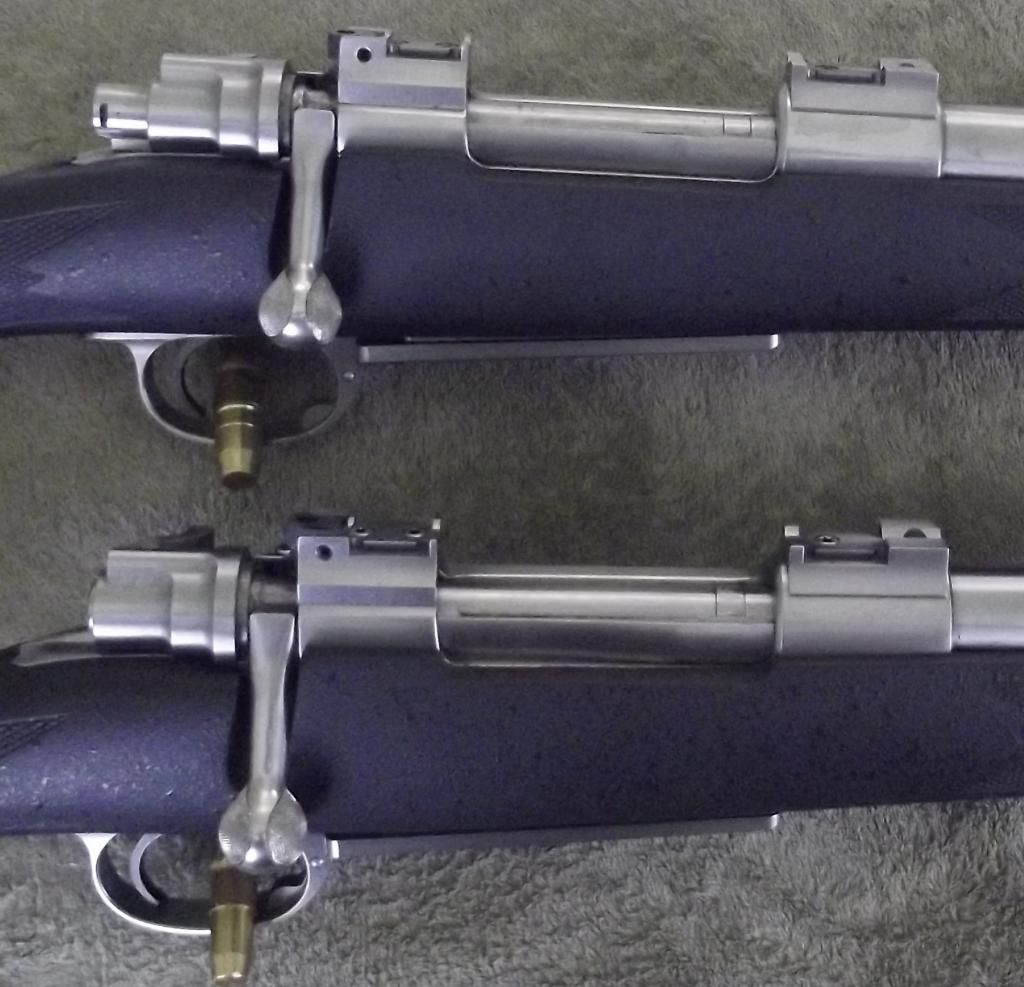 |
This is the most reasonable criteria of all comments. And to expand upon Rine’s post slightly… The bullet manufacturers collectively spend more than one million dollars in advertising annually to entice us to purchase their bullets. Each manufacturer establishes our expectation of how their bullets should perform within the parameters they establish by this advertising. If we comport with their specified use within the performance parameters they’ve established, and their recovered bullet does not closely match the ‘pictorial image’ the manufacturer has portrayed, then the bullet has failed. The bullet has failed not based upon some moving target established by each individual hunter for each individual bullet, the bullet has failed to perform properly based upon the advertised performance standard established by the specific bullet’s manufacturer. This sounds rather simple to me. And using this standard places ‘bullet placement’ solely where it should lie – that being with the individual shooter! Jim "Life's hard; it's harder if you're stupid" John Wayne | |||
|
| One of Us |
Interesting discussion. Now that the TSX has been around for a decade or so there is no doubt about their quick killing capability. One instance of bullet failure I saw was a 243 Win 100gr Hornady RN which pancaked on impactin the shoulder of a feral goat. The animal was killed with a second hot froma 6.5mm. When butchering the animal I found the big surface injury with a big flat piece of lead about 1.5" diameter. "When the wind stops....start rowing. When the wind starts, get the sail up quick." | |||
|
| One of Us |
I have some 100gr RN Interlocks I intend to load in .243 WIN. Do you recall any other details? thank you. | |||
|
| One of Us |
Sorry, I do not remember too much. This was around 1997. The bullets were old stock in the reloading den for at least 10 years. The lead nose looked grey with the white coating. I am not sure if lead oxidises and deteriorates / becomes brittle with age? The velocity would have been max load of around 2950 fps with Win 748. If I were you, I'd do a simple range test with 3 differnt bullets on wet phone books & water filled milk jugs to see what each bullet does. For example the Barnes TSX is a proven penetrator that also causes a lot of trauma in wet paper. The Nosler BT will expand violently and not penetrate much but the early trauma for 8 inches or so is larger than the TSX. It is possible that you will get better results with a lower velocity of say 2700 fps which seems to suit other explosive bullets like the Sierras. Good luck. "When the wind stops....start rowing. When the wind starts, get the sail up quick." | |||
|
| One of Us |
Naki, Thank you for the info and suggestions. | |||
|
one of us |
Please elaborate as to why it was a failure. How can you tell it did not expand. Did you recover the bullet? What was it fired from and at what distance? | |||
|
| One of Us |
This idea could very well come from the actual performance of the Partition. Shortly after entry, the bullet expands and does tramatic damage, then, as the petals are lost or fold back along the shank, the wound channel narrows and on exit, leaves a hole only slightly larger than the bullet. When folks see a entry hole and an exit hole of the same approximate size, they assume that the bullet hasn't expanded when in fact it has performed exactly as intended. Aim for the exit hole | |||
|
| One of Us |
Damn right! Great design. On another note, I've always been little concerned about ttsx expanding. I bought the 200 TTSX for my 350 rem mag. I was shocked how big the hollow point is. I can't imagine it having any trouble expanding. | |||
|
| one of us |
My family has been through tons of bullets, mostly on whitetails with some others thrown in (lots of failures on varmints, they miss their target Failures: 1 (2004)- Mule Deer buck - Remington Core-Lokt factory ammo, 25-06 at 100 yards. Put two through the boiler room, first as it ran out, fell 20 yards later, got up shot the second time running, third shot was at an 8 o'clock to 2 o'clock angle with the deer going away, bullet exploded on impact and did not penetrate and left a silver dollar sized hole at the back of the rib cage, fourth shot through the neck (honesty, second shot of the five shot string was a miss, the numbers above are the hits). No penetration with one bullet, two should be kill shots in the lung/heart area, still required a finisher: My definition of failure. Results that changed the bullets we used (failure - up to interpretation): (1974) - Whitetail doe, .243 with 100 grain partition hand loads, three through the boiler room, poked through without causing enough damage. The chase and follow-up/finishing shot lead to a young hunter becoming a non/anti hunter. Bullet failure 1985 - Whitetail doe, .243 (different than above), 87 grain Sierra spitzer handload, 100 yards. Bullet hit where it should on a broadside shot, hit a rib going in, blew apart, three holes going out destroying/jellying an entire rib cage + and wasting very much meat. Bullet failure? Have changed over to Barnes and no issue so far. Same 25-06 had two DRT on a whitetail doe and buck in succesive years with factory loads and Barnes bullets. Just my thoughts. ______________________ Ken A society grows great when old men plant trees whose shade they know they shall never sit in. --- Greek Proverb | |||
|
| One of Us |
This is probably the best way to look at it... Every "Hunting" bullet out there is 100% perfect for one hunting application... and 100% perfectly wrong for another hunter or hunting application.... I know a whole lot of hunters who have been through a whole lot of different bullets over the years.... It seems like folks sway back and forth between bullets that hammer animals down in their tracks (Very fast expanding/explosive) and bullets that provide deep penetration at the expense of tracking many animals.... with Shot Placement being the key determinant of how far it's tracked... I am thankful that we have so many choices! Thanks | |||
|
| Powered by Social Strata |
| Please Wait. Your request is being processed... |
|

Visit our on-line store for AR Memorabilia

